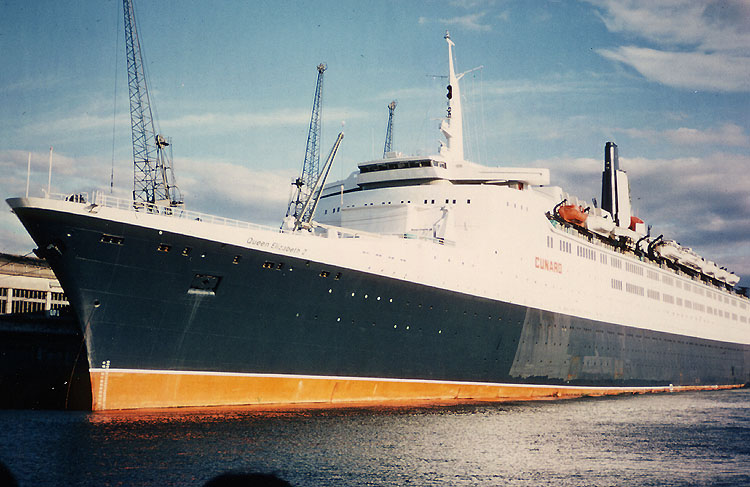| 1. History of Cunard | 2. How it all began | 4.Inside QE2 - Part 2 | 5.Inside QE2 - Part 3 | |
| 6. Home |
Harland & Wolff
Ships
|
|
|
|
Cunard Ships: |
|
..... to the drawing board

|
The advances made in QE2 are attributable to the astonishing rate of technological progress since the war, particularly during the last ten years, which placed it designers' disposal techniques and resources for design for living afloat in the 1970's. Following the sun QE.2 is not a 1969 version of the “ Queens ”, still less a scaled down Q3. She is a resort hotel that has the advantage of being able to follow the sun, and include in her itineraries many ports that her deep-draughted predecessors were incapable of entering. Size has been preserved in QE2, but not at the expense of flexibility of operation. In terms gross tonnage, at 65,000 tons she is amongst the largest of passenger liners, but her draught and dimensions permit her to use the Suez and Panama canals, with access to most of the ports with marketing appeal. For all her size, service speed has been achieved in a hull little smaller in actual dimensions than the “ Queens ”, but offering superior accommodation and amenities for an equal number of passengers. Add to that, one engine room instead of two, two propellers instead of four, a quarter of the engineering officers, and half the fuel consumption - 520 tons instead 1,100 tons. and QE2 begins to reflect the claims made for her. And, what is so important as a practical indication of flexibility is that, running in parallel with the French Line “France”, she will be able to operate a weekly Atlantic service during the summer months when demand surges to capacity figures. The flexible Ship The ship that began to take shape on Cunard's drawing boards in Liverpool , was actually, the first large British ship planned and designed from the start to capture the cream of the North Atlantic trade in the season and the cream of the sun-seeking cruise market in the winter. The ship had to be dual-purpose, and flexible in the fullest sense. An Atlantic liner merely adaptable as a cruise ship would not do. QE2 has been described as the most carefully planned ship ever built. This planning was conducted in full partnership with all the departments operating the ship and catering for her passengers. The contract to build was signed by Sir. John Brocklebank, as Chairman of Cunard, and Lord Aberconway as Chairman of John Brown's on Trafalgar Day, 21 st October 1964 . On 4 th July 1965 , American Independence Day, and the 125th anniversary of the “Britannia's” maiden voyage in 1840 the first prefabricated section of the keel was laid at Clydebank . Fourteen months later No. 736 was ready for launching and on 20 September 1967 H. M. The Queen named her “ Queen Elizabeth 2 ”. From keel to completion occupied just under 3½. years. Work inside was well advanced at the launch, although the task of fitting-out began in earnest once the ship was afloat. Shipbuilding is in large measure an assembling industry; the shipbuilder constructs the hull, and is responsible for creating a critical path analysis of progress so that the arrival in the shipyard of materials of all kinds coincides with the master plan for fitting out.
|
